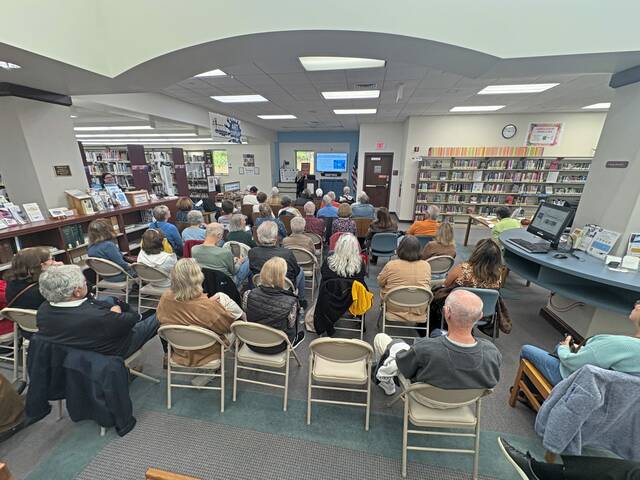CMU expert on AI: There's a constant battle between disinformation and those thwarting it
Artificial intelligence helped U.S. Treasury officials recover about $1 billion from check fraudsters in 2024. It also is the latest tool in the disinformation toolbox, used to create false stories, images and video.
Kathleen Carley, a professor in Carnegie Mellon University’s Software and Societal Systems Department, laid out the good and bad side of AI during a presentation Thursday for the American Association of University Women’s Murrysville chapter.
The group brings in a monthly speaker, often to touch on an issue in the news. Presentations are hosted at the Murrysville Community Library on Sardis Road.
Association policy chair Susan Greenberg said the Murrysville chapter has been hosting monthly speakers since 1971.
“We usually take a survey in May or June to find out what people are interested in hearing about, and then we starting pulling together a program.
Carley said in many small ways, AI is already embedded in everyday life.
“Office workers use it to filter their email, companies use it to make recommendations to customers based on their previous purchases,” she said. “And it can assist you with tasks like checking spelling or helping to write a paragraph.”
But it also plays a pivotal role in the creation and spread of disinformation of all varieties, Carley said, whether that be shaping the narrative around a political figure or trying to influence opinion around a social issue.
And it can be tough for people to recognize.
“Our studies have shown that you as a human being have a difficult time recognizing if something is being posted by a ‘bot’ social media account, especially if it’s saying something you agree with,” Carley said.
Using AI ‘bots’ — unmanned social media accounts that spit out a particular point of view — to reinforce existing beliefs can create what Carley called an echo chamber, where groups of people are essentially cut off from any alternate points of view.
In addition, social media algorithms are designed to feed users with information that will keep them engaged and clicking, which Carley said can create a feedback loop where more and more posts, stories and videos — accurate or not — are fed to a user to reinforce what they already believe.
It can also be used in a much more insidious manner. Carley gave an example that occurred during the Russian invasion of Crimea, Ukraine, in 2014.
“Social media loves to create groups, and in Crimea, there was a group of young men who were all posting soft-core pornography pictures,” she said. “A Russian bot account drew them to one another by recommending other users they might want to follow. Eventually they were all following one another, and at that point the bot switched gears and started talking about the war in Crimea and where you could find weapons to fight with the Russians.”
That group of young men were gradually radicalized, formed a fighting force and took up arms in Crimea.
Carley said there is a ping-pong effect happening right now between those misusing AI and those trying to catch them.
“They get more tools and become more adept at creating fake posts, images and video,” she said. “We get better at detecting them, and then they step their game up again and it keeps going back and forth.”
At the end of the day, Carley said, AI is a tool that takes on the characteristics of the person wielding it.
“It’s like any other tool — it can be used for good or bad,” she said.
Carley provided visual aids for her talk using the library’s TechNook, a screen made possible by a memorial donation. In addition to being used for presentations, AAUW can also invite speakers from around the world, who can’t make the trip to Murrysville.
“It’s worked very well,” Greenberg said. “We try to be timely and the topics are usually things that are important in the news, whether it’s about health or this presentation on AI.”
For more on the Murrysville AAUW speaker series, which is open to the public, see Murrysville-pa.aauw.net.
Patrick Varine is a TribLive reporter covering Delmont, Export and Murrysville. He is a Western Pennsylvania native and joined the Trib in 2010 after working as a reporter and editor with the former Dover Post Co. in Delaware. He can be reached at pvarine@triblive.com.
Remove the ads from your TribLIVE reading experience but still support the journalists who create the content with TribLIVE Ad-Free.

